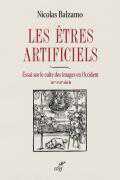Over the past few decades many excellent studies have explored the history of Catholic shrines, pilgrimage sites, and miraculous images in medieval and early modern Europe. Within this ever-expanding literature, Nicolas Balzamo’s essay carves out a distinctive niche for itself through its illuminating focus on an unresolved tension between theory and practice at the heart of Latin Christian image worship from the fourteenth through the seventeenth century: what the author calls the contradiction between «l’égalité ontologique des représentations et l’inégalité de fait qui régnait en ce domaine» (p. 122). Simply put, from c. 1200 onward, the fundamental explanation offered by theologians in the Latin West of why kneeling and praying before statues of saints or the Virgin did not violate the second commandment’s injunction against worshiping graven images was that the images were just representations of the people depicted. «L’usage ancien de l’Église ne les honore pas absolument, en tant que pierres ou autres choses matérielles, soit or ou argent, papier ou parchemin: mais par relation, en référant telle révérence aux saints de Paradis,» Nicole Grenier explained in 1547. By this logic, any representation of a saint ought to be as good as any other to pray before. Yet as pilgrimage and saint worship actually came to be practiced, some images came to be credited with a degree of spiritual power that set them apart from others. Believers made vows or pilgrimages to Our Lady of Winchester or to the Schöne Maria of Regensburg, not to any old statue of the Virgin. An awkward gap opened up between theory and practice that clerical discourse sought to fill in a number of ways.
Part one quickly adduces the evidence suggesting a proliferation of venerated images across the central Middle Ages, before reviewing in more detail central features of their worship between 1300 and 1700, notably the various manners in which believers sought to capture for themselves the supernatural powers believed to emanate from them – by vow, by threat, by pilgrimage, by touching the object, by touching an object that had touched the object, and so forth. A key point of this chapter is that the strongest claims for the powers of specific images were generally made by their clerical guardians. Part two explores the reaction of churchmen and theologians to the practices they saw developing. Both before and after the Reformation, the sharpest criticism of prayer to specific images came from those prepared to break with the established church and attribute the abuse involved to the cupidity of the clergy, but in the fourteenth and fifteenth centuries prominent voices of unquestioned orthodoxy could also assert, as did the mid-fifteenth-century bishop of Avila, Alfonso de Madrigal, that «those who manifest devotion to one image rather than another are guilty of the sin of idolatry.» With the Reformation and Counter-Reformation, such outright condemnation from within the Catholic church became beyond the pale. At the same time, within confessionally divided Europe (although not in Mexico where Catholicism faced no Protestant challenge), no churchman dared to defend the idea that the Virgin or saint was in some manner present within any specific image, lest they seem to prove the Protestant charge that Catholicism encouraged idolatrous worship. How then did churchmen explain why so many believers seemed to credit specific images with extraordinary powers? How did they justify the Church’s allowing enthusiastic worship to continue before such images? Part three, «la cause du peuple,» explores the answers provided to these questions. The most common explanations were that they were either an outgrowth of, or a necessary concession to, the limited intellectual capacities of simple folk – this even though kings were as likely as peasants to have recourse to holy objects, and clerical promotion had been essential to the emergence of the most successful shrines. Ultimately, Balzamo suggests, the various clerical figurations of «le peuple», whether as crudely ignorant or as naively but genuinely pious, «offrait à ses promoteurs l’opportunité de jouer un rôle qu’ils s’étaient eux-mêmes attribués: instruire le peuple et le remettre dans le droit chemin de la saine doctrine, le défendre des calomnies dont il était victime, le mettre à l’abri de controverses et de scandales» (p. 186).
Those seeking to understand the late medieval and early modern cult of images in all of its aspects will want to read this book alongside the other excellent studies listed in its fine selective bibliography. Les êtres artificiels now takes its place among the essential titles on the topic thanks to the insight it provides on the aspects of the phenomenon it highlights.
Zitierweise:
Benedict, Philip: Rezension zu: Balzamo, Nicolas: Les êtres artificiels. Essai sur le culte des images en Occident (XIVe – XVIIe siècle), Paris 2021. Zuerst erschienen in: Schweizerische Zeitschrift für Geschichte 73(1), 2023, S. 54-55. Online: <https://doi.org/10.24894/2296-6013.00120>.
